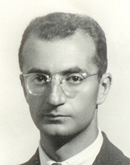

Gian Luigi Banfi
*2. 4. 1910 – Milan, Italy
†22. 4. 1945 – Mauthausen, Austria
Biography
Gian Luigi Banfi was an Italian rationalist and co-founder of the BBPR studio (Banfi, Belgiojosa, Peressuti, and Rogers). He attended the Parrini High School in Milan, where he was classmates with Lodovico Belgiojosa, Enrico Peressuti, and Ernesto Rogers. Like them, he graduated in 1931 with a degree in architecture from the Milan Polytechnic University. In 1932, they jointly founded the architectural and urban planning firm BBPR, which dealt with a wide range of areas, including urbanism, building design, interior furnishing, and design, and collaborated with the most significant architectural magazines.
He was a member of CIAM and attended the congresses in Paris (1937) and Zurich (1939). He took these opportunities to establish contacts with Le Corbusier, Gropius, Giedion, and other key figures of classical modernism. They took a critical stance against the provincialism and isolation of fascist architecture in Italy. The members of BBPR formed an inseparable group with a common way of working. The adoption of racial laws in 1938, which led to the exclusion of their Jewish colleague Ernesto Rogers from public life, resulted in an immediate and definitive break with the regime. Gian Luigi Banfi became a public anti-fascist and in December 1942 co-founded, along with Parri, Calamandrei, Lombardi, La Malfa, and his brother Arialdo Banfi, the Action Party (Partito d'Azione). Key events also included meetings with Ernesto Rossi and Spinelli. The office on Via dei Chiostri became a center for the conspiratorial activities of the Giustizia e Libertà (Justice and Freedom) movement. Banfi, who was called back to military service in 1943, was in Chiavari on September 8, where he organized a military resistance group against the German occupying forces. After returning to Milan, he again actively participated in the resistance. On March 21, 1944, he was arrested along with Belgiojosa due to a denunciation and subsequently imprisoned in the San Vittore prison in Milan. On April 27, 1944, he was deported from platform 21 of the Milan train station to the transit camp Fossoli. After being transferred to the transit camp Bolzano on July 25, he was deported to Mauthausen on August 5, arriving there on August 7. He was eventually transferred to Gusen, where according to the eyewitness account of painter Aldo Carpi, he died on April 10, 1945, at 12:45 PM.
Gian Luigi Banfi was an Italian rationalist and co-founder of the BBPR studio (Banfi, Belgiojosa, Peressuti, and Rogers). He attended the Parrini High School in Milan, where he was classmates with Lodovico Belgiojosa, Enrico Peressuti, and Ernesto Rogers. Like them, he graduated in 1931 with a degree in architecture from the Milan Polytechnic University. In 1932, they jointly founded the architectural and urban planning firm BBPR, which dealt with a wide range of areas, including urbanism, building design, interior furnishing, and design, and collaborated with the most significant architectural magazines.
He was a member of CIAM and attended the congresses in Paris (1937) and Zurich (1939). He took these opportunities to establish contacts with Le Corbusier, Gropius, Giedion, and other key figures of classical modernism. They took a critical stance against the provincialism and isolation of fascist architecture in Italy. The members of BBPR formed an inseparable group with a common way of working. The adoption of racial laws in 1938, which led to the exclusion of their Jewish colleague Ernesto Rogers from public life, resulted in an immediate and definitive break with the regime. Gian Luigi Banfi became a public anti-fascist and in December 1942 co-founded, along with Parri, Calamandrei, Lombardi, La Malfa, and his brother Arialdo Banfi, the Action Party (Partito d'Azione). Key events also included meetings with Ernesto Rossi and Spinelli. The office on Via dei Chiostri became a center for the conspiratorial activities of the Giustizia e Libertà (Justice and Freedom) movement. Banfi, who was called back to military service in 1943, was in Chiavari on September 8, where he organized a military resistance group against the German occupying forces. After returning to Milan, he again actively participated in the resistance. On March 21, 1944, he was arrested along with Belgiojosa due to a denunciation and subsequently imprisoned in the San Vittore prison in Milan. On April 27, 1944, he was deported from platform 21 of the Milan train station to the transit camp Fossoli. After being transferred to the transit camp Bolzano on July 25, he was deported to Mauthausen on August 5, arriving there on August 7. He was eventually transferred to Gusen, where according to the eyewitness account of painter Aldo Carpi, he died on April 10, 1945, at 12:45 PM.
The English translation is powered by AI tool. Switch to Czech to view the original text source.












